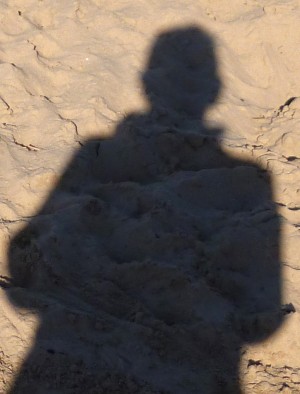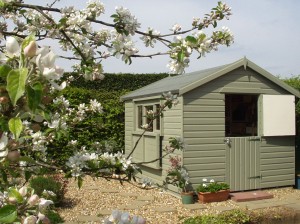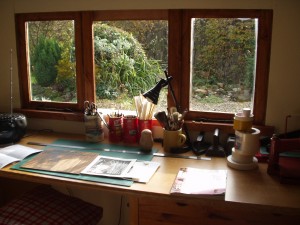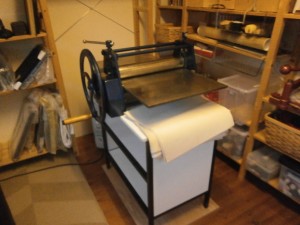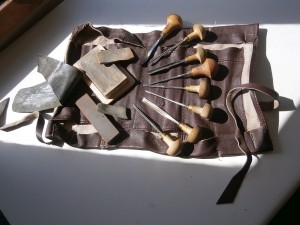DI OLIVER
I work as a printmaker, linocut is probably my medium of choice but I use etching, wood engraving and collograph too. Interpreting the idea as an image is the difficult bit and then the challenge is to make the medium express the idea and I love the technical process involved in that struggle. Look at my prints and see if you think I’ve succeeded or you can listen to me talking about how I work – click on the link below
You can email me at
di.oliver@btinternet.com or di.oliver@dioliver.co.uk
400 people follow me on Pinterest
click on the link to have a look
This is where I work
and my linocut tools
What is an ‘original print’?
Here are some definitions
An original print is an image created from hand cut or a uniquely produced source, such as, plates, stencils or printing blocks, which are used to produce a limited number of prints. The number produced is determined by the artist, or by the actual printing process itself.
Here are descriptions of the various methods
Intaglio
Drypoint: A drypoint needle is used to scratch an image onto a metal or plastic plate. Ink is pushed into these marks. Drypoint relies not only on the scratch provided by the needle but on the burr of material made when scratching the surface. This gives it a line with a velvety fluctuating character. The burr wears away quite quickly and the initial character and intensity of mark will be lost, suitable for small editions.
Mezzotint: The Image is worked from the dark to the lights. A metal plate has a tooth like structure rocked over its surface. This tooth when inked up holds onto the ink and prints with a dense dark tone. The lighter areas of the image are burnished into this tooth, preventing those areas from carrying ink.
Etching: A metal plate is coated with hard or soft wax. Line work can be worked onto the hard wax using an etching needle leaving the metal exposed. Materials can be pressed into the soft wax, again removing wax and exposing the metal. The plate is placed into acid which etches the exposed metal. Ink is then pushed into these etched marks to create the print. A larger edition can be achieved with an etching.
Aquatint: A process to produce a tonal range through etching. A fine powder called Rosin is adhered onto the plate with heat. The palest areas of the image are stopped out, and the plate put in acid for the required length of time to produce the palest grey, with the acid biting the metal in between the particles of Rosin, creating tiny pits that will hold the ink. The palest grey is then stopped out and the plate put back in the acid for the required length of time for the next grey tone, and so on until the darkest tone has been achieved.
Engraving: The image is incised into the surface of a metal plate using a burin/graver or roulette wheel, the burr produced is removed with a scraper tool. Being an Intaglio process it is the incised marks that carry the ink and print. Gives the ability to work with very fine line work
Photopolymer: a prepared, light-sensitive polymer surface on a steel backing. The process was developed in the 1970s. The process needs a graphic image drawn or created on a transparent film (acetate or glass), sun or UV light, and developed in tap water. This method can be also developed and printed in relief.
Collagraph: A technique that relies on the surface quality of different materials glued onto a plate to produce an image. Marks can also be cut and scored into the plate. A collagraph can be printed relief or intaglio, or viscosity printed incorporating both the intaglio and relief parts of the plate at the same time. Usually suitable for small editions due to the short life of plate.
Relief
Lino: A relief printing process where the smooth soft surface of Linoleum is cut using a gouge, or knife. The cut marks do not print, it is the uncut surface, the surface left in relief that carries the ink and prints.
Wood engraving: Uses the end grain of hardwood to enable very fine lines to be incised into the wood, using burins/gravers. The incised marks in the wood do not print with the density of the end grain producing a solid smooth relief surface when printing.
Woodcut: Produced from the side grain of a piece of wood or plank, is usually made using soft woods. The image is mostly worked with the grain of the wood, and the marks are much coarser than with wood engraving, with the character of the wood printings.
Unique prints
Monotype: A unique print created from a matrix (plate, block, screen) that has no Information held on it. The image is created by manipulating the ink on its surface. There is only one, making it as unique as a painting.
Monoprint: A unique print from a matrix that contains information and is capable of making multiples but has been treated in a unique way, either through inking, wiping, chine collé etc. making it a ‘one off’ and unique.
.
